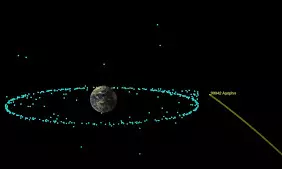
NASA renews mission to intercept 'god of chaos' asteroid approaching Earth's orbit
text_fieldsNASA has reinitiated a mission to explore the asteroid known as 'God of Chaos' as it draws closer to Earth's orbit.
The spacecraft OSIRIS-REx, having recently returned from acquiring samples from the space rock Bennu, has been renamed OSIRIS-APEX (Origins, Spectral Interpretation, Resource Identification, and Security – Apophis Explorer).
Its new objective is to examine the asteroid Apophis during its anticipated close flyby of Earth in 2029. Termed the "God of Chaos," Apophis is projected to pass by Earth on April 13, 2029, at an estimated distance of merely 20,000 miles. Initial estimations suggested a 3% chance of a collision, but subsequent research nullified the possibility of an impact in 2029, reported the New York Post.
In 2021, NASA's Jet Propulsion Laboratory released an animated simulation illustrating the trajectory of asteroid Apophis as it safely traverses near Earth on April 13, 2029.
NASA anticipates that Apophis' proximity to Earth will alter the asteroid's orbit and impact the duration of its 30.6-hour day. Additionally, this close encounter might induce seismic activity and landslides on Apophis, possibly revealing subsurface materials.
Amy Simon, the project scientist for the mission at NASA's Goddard Space Flight Center in Greenbelt, Maryland, said, "OSIRIS-APEX will scrutinise Apophis immediately following its close approach, enabling us to observe surface alterations resulting from its interaction with Earth's gravitational pull."
Asteroids comparable in size to Apophis, approximately 367 yards across (around 340 metres), approach Earth at this proximity only once every 7,500 years.
Dani Mendoza DellaGiustina, principal investigator for OSIRIS-APEX, highlighted the forthcoming close approach as an invaluable scientific opportunity.
"The near approach is a remarkable natural event. We understand that gravitational forces and the accumulation of debris are fundamental processes that might contribute to planetary formation. They could provide insights into the evolution from primordial debris to developed planets," DellaGiustina stated in a recent NASA press release.
By April 2, 2029, OSIRIS-APEX's cameras are scheduled to begin capturing images of the asteroid while the spacecraft closes the distance. Its rendezvous with Apophis is slated for April 13, 2029, where it will observe the asteroid for the ensuing year and a half, monitoring any alterations stemming from the close encounter.
Upon reaching Apophis, the spacecraft will not land but will utilise thrusters to stir the asteroid's surface, allowing scientists to access and analyse the exposed materials.






